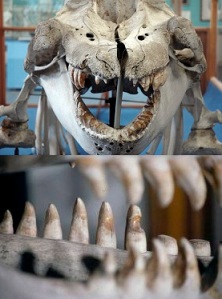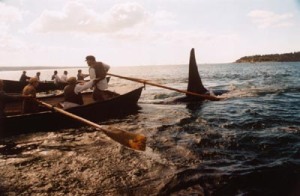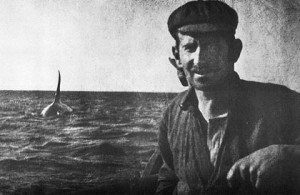We’re comfortable with our position on planet earth. As relatively new to the scene as we are, it does appear as if we’ve taken to the role of World Dominators with peculiar ease. We’re not exactly imposing in and of ourselves. Hell, we’re not even from predatory stock! No claws or fangs… though yes, we do tic the “forward facing eyes” part of the checklist, but that’s only thanks to some ancient ancestor that needed to be able to hop to the next tree over. It was only after we came up with a novel little weapon of our own that we started staking our claim. We’ve adopted the predatory lifestyle with much gusto; but really, we’ve only been at it for a few million years. We’re really just glorified banana eaters. But I digress, the enemies that we haven’t hunted to extinction have been relegated to wildlife reserves or zoos. It was once thought that it was in our nature to elbow everything else out of the way. Our modern sensibilities tend to look down on this view of things, claiming that it’s done nothing but alienate us from the natural order.
We’re at the top of the ladder and, looking around, it’s pretty lonely up here. Or is it? Are there animals that would do the same thing, given the specific sequence of random events that might culminate into what we’d refer to as a chance? I’ll take a step back. Are there animals who find it in their nature to help man further his diabolical ends? Yes, actually. Plenty.
I could go on and on with a list of ‘Budding World Dominators’, but we know how that would end. My posts tend to be long enough as it is! Today, I’ll focus on one of my favorite groups of creatures. The cetaceans. Not only do I like the subject of whales and dolphins, but I like the subject of whales and dolphins acting like completely heartless killing machines. It’s much more fun, and probably closer to reality. So really, we’re not so different.
The advent of modern science has only recently shown us just how intelligent some of our fellow earthlings are. From tool use to culture, the list of candidate creatures continues to grow. One of the more popular entries is, of course, the dolphins. They’re up there in what I call the Famous Four: apes, elephants, corvids, and cetaceans. Communication is key when we’re talking about interaction between species. And not only interaction, but coalitions as I’m proposing. Luckily, it has been recently found that just such exchanges are well within their capacity. Dolphins are expert linguists. Just ask Brin.
Is it just me, or is the thought of an animal intelligence reaching out to communicate with us really freakin’ cool? Let’s begin in Brazil. Off the Atlantic coast of a small town called Laguna, the local fisherman have taken advantage of a strange outreach program doled out by a group of bottlenose dolphin. They (meaning the dolphins) drive shoals of mullet into the shallows near the beach, where they come into the range of the humans and their fishing nets. But it gets better; the dolphins actually signal when and where the fishermen should cast their nets. By thrashing their heads or slapping the surface of the water with their powerful tails, the dolphins appear to be communicating the presence of the fish. On the face of it, it seems a selfless act on the part of the bottlenose pod. Why would they act this way around humans? Please.. don’t get your rain sticks and prayer crystals out just yet, brethren. It turns out that the escaping fish are easier for the dolphins to scoop up individually. It’s a fully fledged, everybody wins, exercise in teamwork. Everybody but the mullet. This isn’t a new behavior either. This collaboration has been going strong since 1847.
But in a post touting blood pacts and promising heirs to earth’s destruction, this may seem kind of weak. What’s the big deal about coordinated fishing? Aren’t they just fish after all? It’s not much of a reach for dolphins to want to fish. Well, yeah – but if you don’t see the fact that dolphins having created a culture that integrates another intelligent species, our species, into the equation as extremely cool, I can certainly up the stakes.
At the beginning of the twentieth century, there had been a particular pod of killer whales that would journey to the mouth of the Port of Eden every year during their annual migrations. For over one hundred years, these over-sized predators visited the south east coast of New South Wales, Australia. They came to be know as the Killers of Eden and they were unlike any other pod of orcas known, before or since.
The killers of the Port of Eden were transients; meaning, they were the variety that have a taste for mammalian blood. For generations, these killers would chase baleen whales up and down the coast of Australia, as they had throughout the rest of the world. While all other killer whales were happy to keep their hunting “in-house”, the Killers of Eden fell upon a very interesting strategy. They would herd their quarry into Twofold Bay before commencing to attack. And this is where things got weird; several individual whales would peel off and cross the bay. Oddly, they would then begin to display at the mouth of the kiah river. Same story as before. The orcas would breach, crashing onto their sides, or pump their flukes through the water. This behavior was called ‘flop-tailing’. All of this was to gain the attention of a certain group of whalers, who would row out to, and be guided by the whales.
That’s right, the killers would inquire for the assistance of human whalers to help bring down their prey. The two deadliest super predators of their respective domains joining forces for mutual, bloodthirsty gain. The humpback whales never stood a chance.
After the deed was done, the killers were allowed first access to the carcass. A kind of accord was made between the whalers and the killers. It was called the Law of the Tongue. It was called this, I’d guess, because orcas feast mainly on the lips and tongue of their kills, leaving most of the valuable portions of the whale untouched. It was only later when the humans would return to the scene, having lashed an anchor to the rotting body, and claim the rest of the remains, such as the valuable bones for scrimshaw and the blubber. It was claimed that this was a kind of subsistence hunting, where the humans rarely took more than what the killers brought in themselves.
As you might imagine, the whalers grew very fond of their fellow hunters. The men went out of their way to free the orcas from fishing nets and in return, it was said that the killers would protect the men from sharks when their boats capsized. Some even called them family, going as far as naming some of the regulars. Names like: Skinner, Hookey, Jimmy, and Montague. This was pretty impressive in itself, as the whalers would usually recognize the whale by it’s particular fin shape and notch pattern of scars. This is the same procedure modern day naturalists go about recording individuals in a pod.
The most famous killer, however, was called Old Tom. He was said to be one of the most outgoing of the killers. Old Tom was usually at the forefront when it came to alerting the whalers to another kill. Because of his proximity to people, many legends sprung up around Old Tom. It was rumored that he was over eighty years old and that (naturally) he was the leader of the pod. He was said to be clever, even pulling the row boats out to the site of an attack by hooking the whaler’s tow lines in his mouth. Old Tom would also grasp harpoon lines after they had been thrown and appeared to play with them. Out of joy or blood lust, we’ll never know. It turns out that such activity might have doomed Old Tom in the end. His corpse was found after it drifted into Snug cove in 1930. When it was studied, it appeared as though his jaw had become infected due to the damage done to his teeth. Some had been worn to the gum line. *It was also discovered post mortem that Old Tom was closer to 35 years old when he died.
Because of overhunting of their prey species, it was theorized that the Killers of Eden eventually disbanded. Breaking up into several pods, they eventually moved on. The last of the original killers to be seen was none other than Old Tom.

The consequence of chewing on tow lines. Viewing the skull, it’s easy to make out the damage done to Old Tom. Also note the teeth on the left side of his lower jaw.
It’s interesting to see just how successful such ventures can be. A stable arrangement was made for more than a hundred years at the Port of Eden. It’s fun to speculate just what kind of legends might have sprung up on the other side of the waterline. Did the killer whales have their own equivalent to the Law of the Tongue, and did we somehow break the pact, causing their eventual dispersal? We have learned just how intelligent these creatures are in recent years, but perhaps the whalers of Eden knew so all along.
What sorts of arrangements would we find ourselves fostering when we finally break the language barrier with other intelligences? Would we stand back in horror when we realized how violent they really are? Would we stand by and allow them the right to pursue their own traditional or social ends? Would we even concede that they’re intelligent at all?





